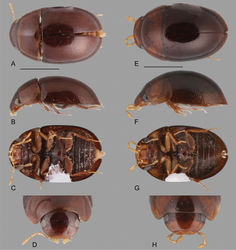Nanosaphes tricolor
| Notice: | This page is derived from the original publication listed below, whose author(s) should always be credited. Further contributors may edit and improve the content of this page and, consequently, need to be credited as well (see page history). Any assessment of factual correctness requires a careful review of the original article as well as of subsequent contributions.
If you are uncertain whether your planned contribution is correct or not, we suggest that you use the associated discussion page instead of editing the page directly. This page should be cited as follows (rationale):
Citation formats to copy and paste
BibTeX: @article{Girón2018ZooKeys, RIS/ Endnote: TY - JOUR Wikipedia/ Citizendium: <ref name="Girón2018ZooKeys">{{Citation See also the citation download page at the journal. |
Ordo: Coleoptera
Familia: Hydrophilidae
Genus: Nanosaphes
Name
Nanosaphes tricolor Girón & Short, 2018 sp. n. – Wikispecies link – ZooBank link – Pensoft Profile
Type material examined
Holotype (male): “SURINAME: Sipaliwini District/ 2.97731°N, 55.38500°W, 200 m/ Camp 4 (low), Kasikasima; sandy/ creek, trail to Kasikasima; leg. A. Short/ 22.iii.2012; SR12-0322-02A/ flotation; 2012 CI-RAP Survey” (NZCS). Paratypes (136): GUYANA: Region XII: “5°17.823'N, 59°50.000'W, 684 m/ Ayanganna Airstrip, trail from/ Blackwater Creek Camp to Potaro/ River; sand/gravel washing in/ gravel bar; leg. A. Short / 18.iii.2014; GY14-0318-03C” (1, SEMC; DNA voucher SLE1067). SURINAME: Sipaliwini District: “2°21.776'N, 56°41.861'W, 237 m/ Camp 3, Wehepai; leg. Short &/ Kadosoe; sandy forest creek/ 4–6.ix.2010; SR10-0904-01A/ 2010 CI-RAP Survey” (47, SEMC, including DNA voucher SLE130); same, except “small stream/ 5.ix.2010; SR10-0905-01A” (1, SEMC); same, except “2°19.280'N, 56°52.595'W, 224 m/ Rapids on Kutari River/ leg. A.E.Z. Short; forest stream/ 18.viii.2010; SR10-0818-01A” (1, SEMC); same, except “2.97731°N, 55.38500°W, 200 m/ Camp 4 (low), Kasikasima; sandy/ stream on trail to METS camp/ 20.iii.2012; SR12-0320-02A” (4, SEMC); same data as holotype (9, SEMC); same, except “04°42.480'N 56°13.159'W, 24 m/ Raleighfallen Nature Reserve, trail/ to Raleighfallen; creek margins/ leg. Short, McIntosh, & Kadosoe/ 27.vii.2012; SR12-0727-03A” (3, SEMC); same, except “04°40.910'N, 56°11.138'W, 78 m/ Raleighfallen Nature Reserve / Voltzberg Station; sand bar in/ stream; leg. C. McIntosh / 29.vii.2012; SR12-0729-02C” (8, SEMC); same, except “Votlzberg trail; margin of stream; leg. C. Maier, V. Kadosoe; 30.vii.2012; SR12-0730-01A” (1, SEMC); “2°00.342'N, 55°58.149'W, 337 m/ Sipaliwini Savanna Nature Res./ 4-Brothers Mts.; clearwater stream/ sandy w/detritus; 31.iii.2017/ leg. Short & Baca; SR17-0331-01B” (32, SEMC); same, except “sandy w/ emergent veg; SR17-0331-01C” (19, SEMC); same, except “at night; leg. Short; SR17-0331-01F” (10, SEMC).
Differential diagnosis
Nanosaphes tricolor can be easily recognized by its smooth elytra (as opposed to rather coarsely punctate as in N. punctatus, see Fig. 15E, F), and the coloration pattern along the body, with uniformly dark brown head (including the clypeus, see Fig. 16D), yellow pronotum and brown elytra (see Fig. 16A, B; as opposed to uniform brown coloration along the body as in N. castaneus, Fig. 15E, H). It is similar to N. hesperus in the paler coloration of the pronotum, but differs from it by the uniform and darker coloration of the head (orange in N. hesperus) and the weak development of the longitudinal elevation of the mesoventrite (as opposed to strongly elevated as to form a sharp and pointed carina in N. hesperus).
Description
Body length 1.1–1.4 mm, width 0.7–0.75 mm. Body elongate oval, weakly convex, with uniformly dark brown head (including clypeus, Fig. 16D), yellow pronotum and brown elytra (Fig. 16A, B). Dorsal surface shallowly punctate. Posterior elevation of mesoventrite weakly carinate. Pubescence of ventral surface very dense. Aedeagus (Fig. 18A) with basal piece nearly 0.6-times the length of parameres; parameres slightly shorter than median lobe, with obliquely round apex; gonopore situated near apical third of median lobe.
Etymology
Noun in apposition. Named after the three colors present along the body of the beetles (uniformly dark head, yellow pronotum and brown elytra), with the Latin prefix tri meaning three and the Latin word color.
Distribution
Guyana, Suriname. Elevation range 24–684 m. See Fig. 19.
Biology
This species has been collected along the margins of forested streams (see Fig. 20D, F).
Original Description
- Girón, J; Short, A; 2018: Three new genera of acidocerine water scavenger beetles from tropical South America (Coleoptera, Hydrophilidae, Acidocerinae) ZooKeys, (768): 113-158. doi
Images
|





